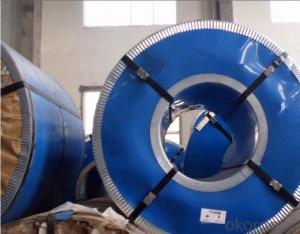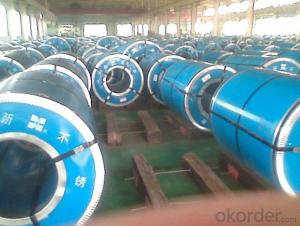Stainless Steel Coil Annealing and Pickling No.1 Finish Hot Rolled
- Loading Port:
- Guangzhou
- Payment Terms:
- TT OR LC
- Min Order Qty:
- 100 m.t.
- Supply Capability:
- 8000 m.t./month
OKorder Service Pledge
OKorder Financial Service
You Might Also Like
Hot / Cold Rolled Stainless Steel Coil
1. | Item | STAINLESS STEEL COIL | ||
2. | Standard | ASTM,AISI,GB,JIS,SUS,EN,DIN,etc. | ||
3. |
Material | 200 series | 300 series | 400 series |
201,202 | 300,301,304,304L,309S,310S,316Ti,316L, 317L,321,329,329LA,329LD | 409,410,430,430LX,600,601 | ||
4. |
Specification | Thickness | 0.1mm-200mm | |
Width | 1000mm-3000mm | |||
Length | 1m-12m | |||
5. | Surface | No.1,No.4,No.5,BA,2B,hair line,embossed,mirror finish,etc | ||
6. | Application | Stainless steel coils s are widely used in: 1:Chemical industry equipment,industrial tanks 2:Medical instruments,tableware,kitchen utensil,kitchen ware. 3:Architectural purpose,milk or food processing facilities. 4:Hospital equipment,interior exterior decoration for building 5:Architectural purposes,escalators,kitchen ware,vehicles. Or they can be made as your requirement. | ||
7. | Package | Standard export package. | ||
8. | Export to | Asia,Africa,Europe,Middle East,South and North America,Oceania,etc | ||
9. | Contact | please feel free to contact CNBM | ||
- Q:Can stainless steel strips be used in the chemical industry?
- Stainless steel strips are indeed applicable in the chemical industry. Renowned for its exceptional resistance to corrosion, stainless steel emerges as the perfect selection for environments containing chemical substances. It can endure contact with different chemicals, acids, and alkalis, enabling its utilization in chemical storage tanks, pipes, valves, and fittings. Moreover, stainless steel strips exhibit durability, ease of cleaning, and the ability to retain their strength and integrity under severe chemical conditions. Consequently, they enjoy extensive employment in the chemical industry due to their dependability and long-lasting nature.
- Q:Can 111 stainless steel strips be passivated to enhance corrosion resistance?
- Yes, 111 stainless steel strips can be passivated to enhance corrosion resistance. Passivation is a process that removes iron from the surface of stainless steel and forms a protective oxide layer. This oxide layer acts as a barrier, preventing further corrosion and providing increased resistance to environmental factors such as chemicals, moisture, and temperature. Passivation is commonly used in various industries, including automotive, aerospace, medical, and food processing, to improve the longevity and performance of stainless steel components. Therefore, by passivating the 111 stainless steel strips, their corrosion resistance can be enhanced, leading to improved durability and reliability in their intended applications.
- Q:Can stainless steel strips be used in the automotive industry?
- The automotive industry can make use of stainless steel strips, which are versatile and durable. Stainless steel is a material that offers numerous advantages for automotive applications. It possesses excellent corrosion resistance, making it capable of withstanding harsh environmental conditions and exposure to road salts or chemicals. Moreover, stainless steel strips are resistant to heat and can endure high temperatures, making them suitable for various automotive components like exhaust systems and engine parts. Additionally, they possess high strength and can provide structural support and reinforcement for automotive frames and body panels. Furthermore, they can be utilized for decorative purposes, enhancing the aesthetic appeal of vehicles. All in all, stainless steel strips are a dependable and valuable material choice for the automotive industry.
- Q:Are stainless steel strips suitable for chemical pipes?
- Yes, stainless steel strips are suitable for chemical pipes. Stainless steel is highly resistant to corrosion, making it an ideal material for piping systems that handle chemicals. It has excellent resistance to a wide range of chemicals, including acids, alkalis, and solvents. Stainless steel's resistance to corrosion is due to the presence of chromium, which forms a protective oxide layer on the surface of the metal, preventing further corrosion and ensuring the longevity of the pipes. Additionally, stainless steel is known for its high strength and durability, making it capable of withstanding the high pressures and temperatures often associated with chemical processing. Overall, stainless steel strips are a reliable and suitable choice for chemical pipes.
- Q:Are stainless steel strips suitable for elevator interiors?
- Elevator interiors can benefit from the use of stainless steel strips, which are highly suitable for this purpose. Stainless steel is a versatile and durable material that finds widespread use in various applications, including elevator interiors. Its exceptional properties make it an ideal choice for this application, as it resists corrosion, requires minimal maintenance, and maintains a polished and sleek appearance over time. By incorporating stainless steel strips, the elevator interior's aesthetic appeal can be enhanced, resulting in a modern and sophisticated look. Moreover, stainless steel is easy to clean and sanitize, ensuring a hygienic environment, especially in areas with high foot traffic. In conclusion, stainless steel strips offer a practical and suitable option for elevator interiors, combining durability and aesthetic charm.
- Q:What are the factors affecting the strength of 111 stainless steel strips?
- The strength of 111 stainless steel strips can be influenced by various factors. These factors include the composition of the steel, the heat treatment process, the amount of cold working applied, the grain size, the surface finish, the environmental conditions, the manufacturing process, and the design considerations. Regarding composition, the strength of the steel can be greatly impacted by the chemical composition, particularly the levels of elements such as nickel, chromium, and molybdenum. Higher amounts of these elements generally result in increased strength. The heat treatment process used during manufacturing is another significant factor. Annealing, quenching, and tempering can alter the microstructure of the steel, leading to changes in strength. The amount of cold working or deformation applied to the steel during processing is also important. Cold working can enhance strength by introducing dislocations, but excessive cold working can cause brittleness. The grain size of the steel is another influential factor. Smaller grain sizes tend to result in higher strength due to increased grain boundaries, which hinder dislocation movement. The surface finish of the steel can affect its strength, particularly in terms of fatigue resistance. Smooth and polished surfaces tend to improve the material's fatigue strength. The environment in which the steel is used can impact its strength as well. Factors such as temperature, humidity, and exposure to corrosive substances can lead to degradation and reduced strength over time. The specific manufacturing process employed can also influence the strength of the steel. Variables such as rolling techniques, annealing processes, and cold reduction methods can all have an impact. The design of the steel, including factors like thickness, width, and the presence of surface defects or notches, can also affect strength. Proper design considerations should be made to ensure optimal strength and performance. It is important to note that these factors are interconnected, and changes in one factor can influence the others. Manufacturers and engineers must carefully consider all these factors to achieve the desired strength and performance of 111 stainless steel strips.
- Q:How do stainless steel strips perform in the presence of hydrochloric acid?
- Stainless steel strips generally perform well in the presence of hydrochloric acid due to their high corrosion resistance properties. Hydrochloric acid is a highly corrosive substance that can deteriorate many metals, but stainless steel has a unique composition that makes it resistant to this type of chemical attack. The presence of chromium in stainless steel forms a protective oxide layer on the surface, which prevents the acid from reaching the underlying metal and causing corrosion. Additionally, stainless steel contains nickel, which further enhances its resistance to acids. However, it is important to note that the performance of stainless steel in hydrochloric acid can vary depending on the grade and specific conditions of exposure. Higher grades of stainless steel, such as 316 or 904L, are often preferred for more aggressive acid environments. It is recommended to consult with material experts or refer to corrosion resistance charts to select the appropriate stainless steel grade for specific hydrochloric acid applications.
- Q:Can stainless steel strips be used in pressure vessel manufacturing?
- Certainly, pressure vessel manufacturing can utilize stainless steel strips. Stainless steel, an alloy of steel with a minimum chromium content of 10.5%, offers remarkable corrosion resistance and durability. These attributes render stainless steel strips appropriate for pressure vessel manufacturing, enabling them to endure high-pressure surroundings and fend off corrosion caused by diverse substances. Moreover, stainless steel excels at maintaining its structural integrity even under elevated temperatures, making it an optimal selection for pressure vessel applications necessitating heat resistance.
- Q:Are stainless steel strips affected by UV radiation?
- Yes, stainless steel strips are generally not affected by UV radiation. Stainless steel is highly resistant to corrosion and does not undergo significant changes when exposed to UV radiation.
- Q:Can stainless steel strips be used in the automotive stamping industry?
- Yes, stainless steel strips can be used in the automotive stamping industry. Stainless steel is known for its durability, corrosion resistance, and strength, making it suitable for various automotive applications. It can be formed, stamped, and fabricated into different shapes and sizes to meet the specific requirements of the automotive industry.
1. Manufacturer Overview |
|
|---|---|
| Location | |
| Year Established | |
| Annual Output Value | |
| Main Markets | |
| Company Certifications | |
2. Manufacturer Certificates |
|
|---|---|
| a) Certification Name | |
| Range | |
| Reference | |
| Validity Period | |
3. Manufacturer Capability |
|
|---|---|
| a)Trade Capacity | |
| Nearest Port | |
| Export Percentage | |
| No.of Employees in Trade Department | |
| Language Spoken: | |
| b)Factory Information | |
| Factory Size: | |
| No. of Production Lines | |
| Contract Manufacturing | |
| Product Price Range | |
Send your message to us
Stainless Steel Coil Annealing and Pickling No.1 Finish Hot Rolled
- Loading Port:
- Guangzhou
- Payment Terms:
- TT OR LC
- Min Order Qty:
- 100 m.t.
- Supply Capability:
- 8000 m.t./month
OKorder Service Pledge
OKorder Financial Service
Similar products
New products
Hot products
Hot Searches
Related keywords






























